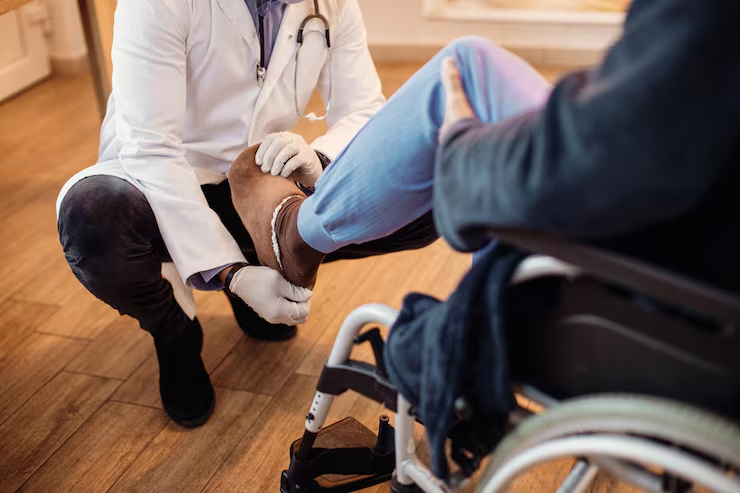
Hearing the word “surgery” can feelintimidating, especially when it involves your feet and ankles — the veryfoundation of how you move every day. Whether it’s a bunion correction, Achilles tendon repair, or ankle stabilization, surgery may become the bestoption when conservative treatments are no longer effective. Knowing what toexpect before and after surgery can help patients feel more confident,prepared, and empowered in their recovery journey.
Not every foot or ankle conditionrequires surgery. In fact, most problems like plantar fasciitis, tendonitis,and mild arthritis respond well to non-surgical care such as physical therapy,bracing, injections, and orthotics. Surgery is typically recommended when painpersists despite months of conservative treatment, or when a condition issevere enough that it interferes with walking, work, or athletic performance.
Common surgical reasons include bunionsthat make shoes difficult to wear, chronic ankle instability from repeated sprains, painful hammertoes, fracturesthat require alignment, Achilles tendon ruptures, and advanced arthritis thatlimits mobility. A detailed exam and imaging studies such as X-rays or MRI helpdetermine if surgery is the right option.
Preparation is one of the most importantsteps toward a smooth surgical experience. Patients often begin with apreoperative consultation, where the surgeon explains the procedure, expectedoutcomes, and potential risks. This is the time to ask questions aboutanesthesia, recovery timelines, and post-op restrictions.
Medical clearance may be needed,especially for patients with conditions like diabetes, heart disease, orhypertension. Pre-surgical labs or EKGs ensure the patient is in good health toundergo anesthesia. Certain medications such as blood thinners may need to bestopped before surgery.
Patients should also plan their homeenvironment. Setting up a recovery area with easy access to essentials,arranging for help with daily activities, and preparing meals in advance canmake the initial post-op period less stressful. For surgeries that limitweight-bearing, devices like knee scooters, crutches, or walkers may berecommended.
Most foot and ankle surgeries are performed on an outpatientbasis, meaning patients go home the same day. Depending on the procedure,anesthesia may be local (numbing only the foot), regional (numbing from theknee down), or general (complete sleep).
The length of the surgery depends on thecomplexity. A hammertoe correction may take under an hour, while an ankleligament reconstruction or joint replacement may take several hours. Patientsare typically monitored in a recovery area before discharge.
Post-surgery, the focus shifts to pain management,wound care, and protecting the surgical site. Patients usually go home in asplint, cast, or boot to immobilize the area. Elevation is crucial during thefirst week to minimize swelling. Pain medications, often a combination ofover-the-counter anti-inflammatories and prescribed medication, help keepdiscomfort under control.
It’s normal to experience swelling,bruising, and stiffness initially. Following instructions closely — includingrestrictions on walking or driving — helps prevent complications. Patientsshould be on the lookout for warning signs such as increasing pain, fever, orunusual drainage, which could indicate infection.

Recovery varies widely depending on thesurgery performed. Some minor procedures allow walking within a few days in aprotective shoe, while more complex reconstructions require weeks or evenmonths of limited weight-bearing.
In general, soft tissue procedures liketendon repairs may require six to twelve weeks for healing, while boneprocedures such as fusions or osteotomies may take three to six months beforepatients feel close to normal. During this time, follow-up appointments withthe surgeon are essential to monitor healing progress.
Physical therapy often plays a key rolein recovery. Therapy restores range of motion, strengthens surrounding muscles,and retrains balance. Skipping therapy can prolong recovery or increase therisk of re-injury.
One of the most common questions patientsask is, “When can I get back to normal?” The answer depends on both the type ofsurgery and the individual’s lifestyle. Someone with a desk job may return towork sooner than someone with a physically demanding job that requires standingor heavy lifting.
Athletes often require structuredreturn-to-play programs, ensuring their foot or ankle is strong and stableenough to handle sports-specific movements. For patients with arthritisprocedures like ankle replacement, the goal is usually to return topain-free walking and recreational activities, though high-impact sports maynot always be realistic.
Like any surgery, foot and ankleoperations carry risks such as infection, nerve irritation, blood clots, ordelayed healing. The good news is that these risks are relatively low whenpatients follow medical instructions carefully. Maintaining good nutrition,avoiding smoking, and keeping blood sugar well-controlled in diabetic patientsare all factors that support proper healing.
Wearing appropriate footwear afterrecovery and continuing strengthening exercises can help protect the results ofsurgery. In many cases, surgery is not just about correcting a problem but alsoabout setting the stage for better long-term foot health.
Some patients hesitate to pursue surgerybecause they’ve heard myths like “you’ll never walk normally again” or “allfoot surgery is extremely painful.” While discomfort and downtime are expected,advances in surgical techniques, anesthesia, and recovery protocols havedramatically improved patient outcomes. Many patients walk comfortably andreturn to active lifestyles once healing is complete.
Another myth is that surgery should bedelayed as long as possible. While conservative treatment is always preferredfirst, waiting too long can sometimes make a condition worse and limit surgicaloptions.
Foot and ankle surgery can sounddaunting, but for many patients, it is the key to getting back on their feetwithout constant pain. Understanding what to expect before and after theprocedure allows patients to feel prepared and engaged in their recovery. Withthe right preparation, professional care, and dedication to rehabilitation,surgery can provide long-lasting relief and restore quality of life.